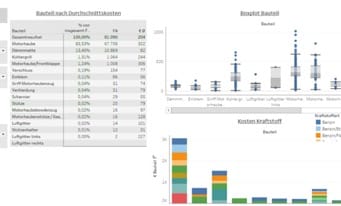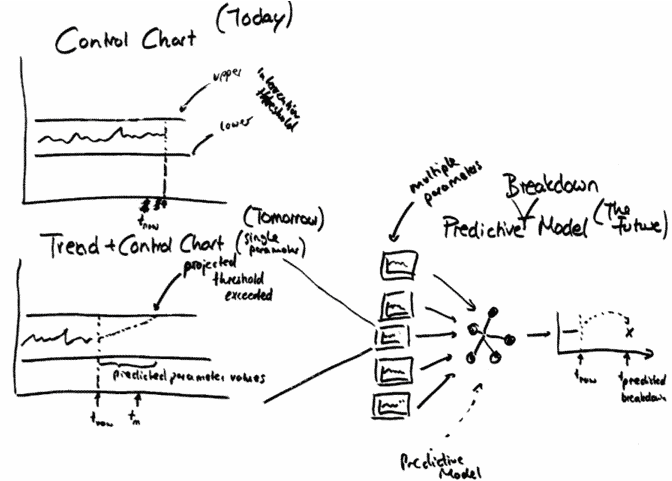Predictive maintenance use cases are among the most frequently implemented use cases in the field of Industry 4.0. In this blog article, we have compiled five predictive maintenance use cases that we have implemented in order to work out what they are and what potential predictive maintenance has in Industry 4.0.
If the "Maintenance" symbol lights up in the dashboard of a car, this does not mean that something is already wrong with the engine or another part. As a rule, the next regular visit to the workshop is due after a certain number of kilometres. The logic behind this maintenance approach belongs in the age of Artificial intelligence and data science are a thing of the past.
Today, conventional maintenance approaches are increasingly being replaced by a new approach: predictive maintenance. Using the example of Five Predictive Maintenance Use Cases we show below how broad the range of applications of the new predictive maintenance approach is.
Inhaltsverzeichnis
1. cross-manufacturer failure probability of vehicle components based on vehicle characteristics
Patterns in data play a central role in predicting maintenance dates. Patterns reveal causal relationships especially when the data have a uniform source - such as sensor data from one and the same engine type. The particular challenge in this project was that we were confronted with an asymmetrical level of information in the area of used car sales. This necessitated a selective data collection of the vehicle's condition in order to enable a manufacturer-independent view of the components. This required a data collection of the component defects independent of previously carried out vehicle repairs.
Our solution initially saw the Carrying out a Frequency analysis of failed components. This was followed by the ranking of the components according to core factors of the used vehicles. The result was a data model for linking defect logs and workshop reports. Through the introduction of an interactive component ranking according to failure probability and influencing factors also created transparency about the analytical value of the data. value of the data situation.

2. preventive identification of defective parts to identify parts potentially at risk of failure along the production and logistics process all the way to the customer.
Quality assurance is one of the central challenges of companies, especially in the premium segment. An automobile manufacturer wanted Vehicle breakdowns trace back to the logistics and identify them. Until now, the whereabouts of potentially failure-prone parts from defective supplier batches could not be traced and carried a risk. In order to ensure quality, the affected parts are to be identified in logistics and at the customer's premises.
With a generic data model, we first ensured the linking of the data sources along the production process. This made it possible to trace the defective parts back to the supplier and to visualise the process. With the QlikSense application, it is now possible to locate the parts in logistics and at the customer. The generic data model also enables the identification of different parts that have failed at the customer.
Tip:
Take a look at other application areas and use cases on the topic of AI in logistics an.
3. predictive maintenance on vending machines: Component-based repairs on a daily basis
An international technology group approached us with a request, Avoid failures at certain ATMsin order to save costs. The high availability of the automatsn played a very important role and should be ensured. First of all, the relevance, the Data quality and the set of potentially important data sources is assessed to determine a meaningful outcome variable and predictive quality using descriptive and visual analyses (Visual Data Exploration) to evaluate.
Within the framework of the feasibility analysis, the need first arose to improve the data basis. For this purpose, 1TB of the existing data sources were evaluated in relation to the specific predictive maintenance use case. In this way, the basis for the Successful implementation of the maintenance algorithm created.

Description: A critical component of any predictive maintenance use case is the data basis. Because here the equation: Garbage in, garbage out.
4 Predictive Maintenance Potentials & Enablement: Potentials in the Service of a Measurement and Transmission Technology Manufacturer
A measurement and transmission technology manufacturer was confronted with the question of how to Improve service for its product portfolio could be used. Since the company did not yet have extensive experience with predictive maintenance use cases, the potential for further use cases was to be evaluated at the same time. The high availability and quality of the transmission system had to be taken into account.

In order to first clarify which data could be used and which predictive maintenance use cases could be derived from it in order to extract added value from data, a Data Science Roadmap Workshop carried out. This enabled us to present our client with all the starting points for meaningful business cases. Subsequently, a storyline for a pilot project was developed and presented to the client. In a short period of time, we succeeded in Methodological knowledge to enable the electronics manufacturer to classify the topic and drive it forward in further predictive maintenance use cases.
5. piloting a maintenance optimisation prototype: A prototype for optimising maintenance windows in the production line of an automotive company.
One automotive group already had a developed R prototype for optimising maintenance windows, which was now to be tested in live operation. In the process, the prototype had to be fed with data from the HDFS (Hadoop Distributed File System) and the results written to a database. One difficulty was that the data format differed from the format used in the prototype.
Our solution initially involved the creation of a Data Pipeline which read the data from the HDFS and converted it into the supported format. This allowed the results to be calculated using the prototype and then written to the database. Subsequently, the runtimes of the prototype were optimised and the data pipeline was automated. Finally, the test and its evaluation took place in live operation. In the end, we succeeded in recalculating the maintenance windows every minute and visualising the results directly on the screens of the production line.
Conclusion: Predictive Maintenance Use Cases
The five predictive maintenance use cases presented here show how diverse the use cases for predictive maintenance can be. In the concrete planning and implementation of issues, it is often also a matter of clarifying the fundamentals - which data can be used? Is the data quality right? Which business cases make sense and what priority do they have in the implementation? To clarify questions like these, we often first conduct data workshops.
Predictive maintenance plays a particularly important role in this context. data-driven digitalisation play a role. Here, the question is becoming more and more urgent as to how, in the context of data-driven business models added value can be generated from the existing data. From our perspective, there is much more potential in predictive maintenance use cases - be it in the classic maintenance of machines and vehicles, in the areas of logistics and sales, service or networked production.







0 Kommentare